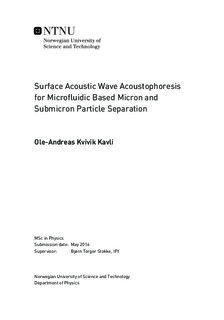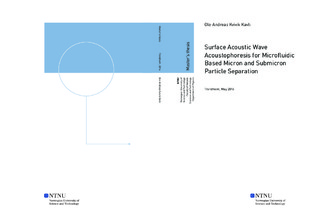| dc.description.abstract | Microvesicles secreted from our cells referred to as exosomes contain vital information on our health status and are believed to revolutionize early diagnosis. Therefore, separation of such particles is a growing field within point-of-care diagnostics, however, there are yet many limitations that need to be addressed in able to successfully separate exosomes from blood samples. The motivation for this study is to investigate how surface acoustic waves (SAW) based acoustophoresis may be used for separation of submicron particles from a bidispers particle suspension (micron and submicron sized particles) in a microfluidic device.
For a microfluidic channel aligned between two SAW generating interdigital transducers (IDTs) standing surface acoustic waves (SSAW) will form in the SAW propagating medium, generating pressure nodes and anti-nodes inside the fluid. As a result, acoustic radiation forces will affect particles submerged in the fluid, depending on the particle size and the SAW frequency. IDT designs with different pitch, resonance frequency and reflector structures were fabricated; their frequency response were measured, and they were implemented together with a microfluidic channel to form an acoustophoresis device. Specifically, the effect of\\ acoustophoresis and various IDT designs were investigated for the separation of bidisperse polystyrene particle sample.
Frequency response measurements of the various IDT designs favors the 100 µm pitch IDT with reflectors. 3.0 µm polystyrene particles were successfully separated from 0.5 µm particles using the 100 µm pitch IDT design, while 1.0 µm and 0.2 µm polystyrene particles were only partially separated. The 50 µm pitch IDT device did successfully sort out the 1.0 µm particles, however, the 0.2 µm particles were not centered in the channel and the separation was only partially successful. Misalignments between the microfluidic channel and the IDTs during fabrication proved to be the main challenge for reproducible results, altering the locations of the pressure nodes and anti-nodes in the channel. The results for the devices are promising as a potential on-chip separation technique, however, to continue with further studies on submicron particle separation by SSAW the alignment accuracy has to be improved. | |

